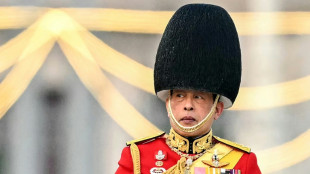

Queen Elizabeth II: a lifetime of service
Elizabeth II has been on the throne since she was 25, an ever-present figure for the lives of most people in Britain, as well as one of the most recognisable people around the world.
Now 96, difficulties in walking and standing have made her dwindling number of public appearances in recent years decline further.
Her eldest son and heir Prince Charles, 73, has gradually assumed more responsibilities to prepare him for the time when he takes over.
But she still regularly hosts foreign dignitaries and diplomats. According to those who know her, she remains sharp as a tack.
The death in April last year of her husband of 73 years, Prince Philip, inevitably affected her deeply and she cut a lonely figure at his funeral, which was held under coronavirus restrictions.
She has spent most of her time at her favoured Windsor Castle home west of London, after leaving Buckingham Palace at the start of the pandemic in early 2020.
No British monarch in history has celebrated a Platinum Jubilee and her 70-year reign is reflected by her presence almost everywhere, from stamps and banknotes to her cypher on post boxes.
Her popularity with the public has remained consistently high, even as deference lessened and attitudes changed towards the monarchy over the decades.
- Duty calls -
Elizabeth Alexandra Mary Windsor was born in London on April 21, 1926, and only became queen by an accident of history.
Her father became king George VI in 1936 when his elder brother, Edward VIII, abdicated to marry a twice-divorced American, Wallis Simpson.
That made princess "Lilibet" heir to the throne.
As German bombs rained down on London in World War II, she and her younger sister Margaret were evacuated to Windsor.
At the age of 19, she became an army mechanic and driver on the Home Front, endearing herself to Britons for her part in the war effort.
At 21, she married Philip Mountbatten, the son of a Greek prince, at a ceremony that brought a dash of glamour to austere post-war Britain.
The couple were in Kenya on February 6, 1952, when news reached them of her father's death, making her the new monarch.
She returned to Britain immediately and on June 2, 1953, was crowned queen of the United Kingdom, Australia, Canada, New Zealand, South Africa, Pakistan and Ceylon (modern-day Sri Lanka).
Currently, she is head of state in the United Kingdom and 14 other Commonwealth countries.
With a sense of duty instilled in her since childhood, the queen carried out hundreds of engagements each year, from receptions for foreign dignitaries to awarding civilian and military honours, and royal visits around the world.
- Rock of stability -
Elizabeth spent an unscheduled night in hospital last October after undergoing unspecified tests. Doctors have since advised her to rest and reduce her workload.
For support in fulfilling her duties, she has turned to her immediate family but one without two notable members -- second son Prince Andrew and grandson Harry.
Andrew, often considered to be her favourite son, has been stripped of his royal functions due to his links to the convicted sex offenders Jeffrey Epstein and Ghislaine Maxwell.
Harry quit royal life in 2020 and moved to the United States, from where he and his wife Meghan accused the family of racism.
Over the decades, the queen has been seen as a rock of stability in the turbulence of royal life.
In 1992 -- a year she called her "annus horribilis" -- three of her four children split from their partners, and Windsor Castle went up in flames.
But she faced criticism in 1997 for misjudging the public mood after the death of princess Diana in a Paris car crash, by initially refusing to return to London and fly the flag at half-mast over Buckingham Palace.
Even though she makes a recorded televised address every Christmas Day, she has never given an interview and is careful not to divulge her personal opinions.
As head of a constitutional monarchy, she is politically neutral, and her weekly private conservations with the prime minister of the day about current issues remain just that -- private.
Summers have typically meant a stay at her Balmoral retreat in northeast Scotland, where she swaps her self-styled "uniform" of formal hats and matching outfits for the country look, complete with a simple headscarf and Wellington boots.
An avid owner of corgis and a horse rider since was young, she was also still in the saddle as she moved into her 90s.
T.A.Smith--RTC


